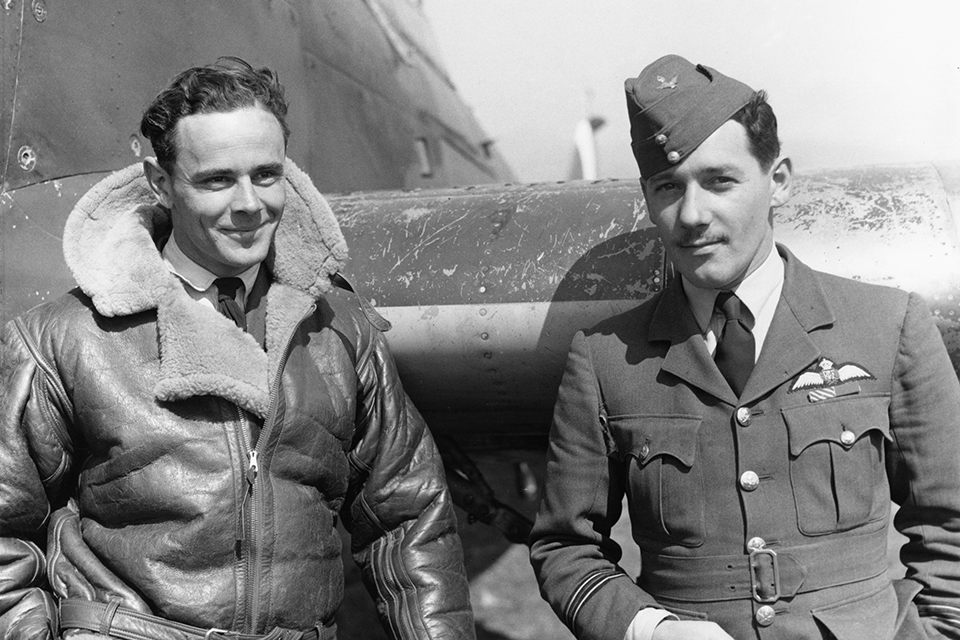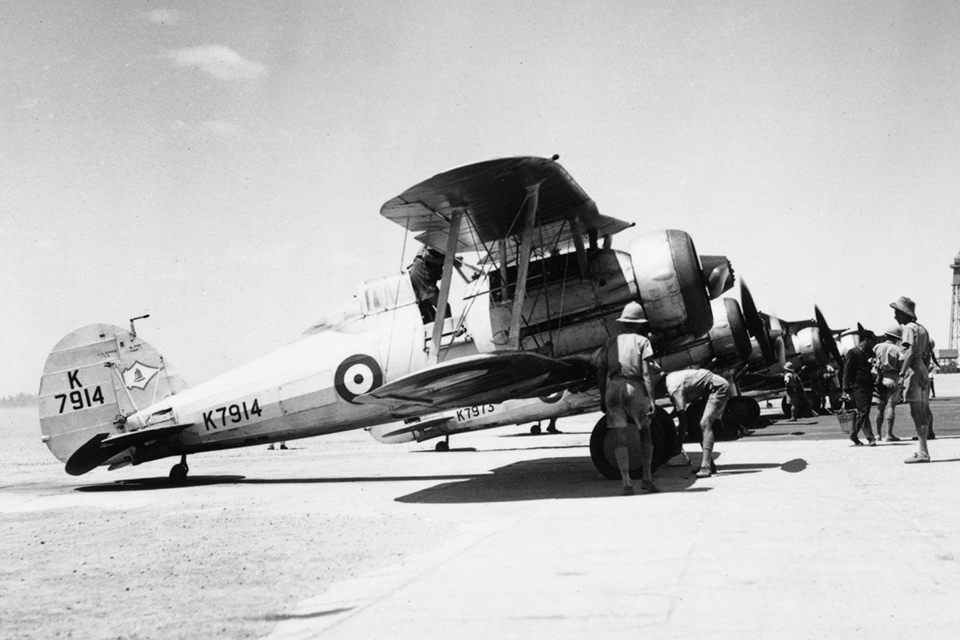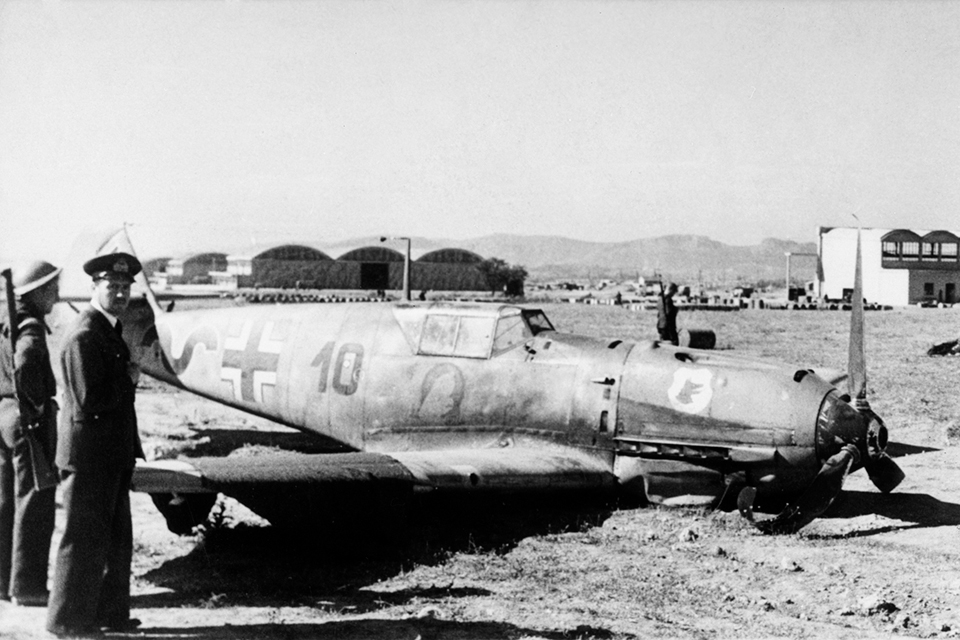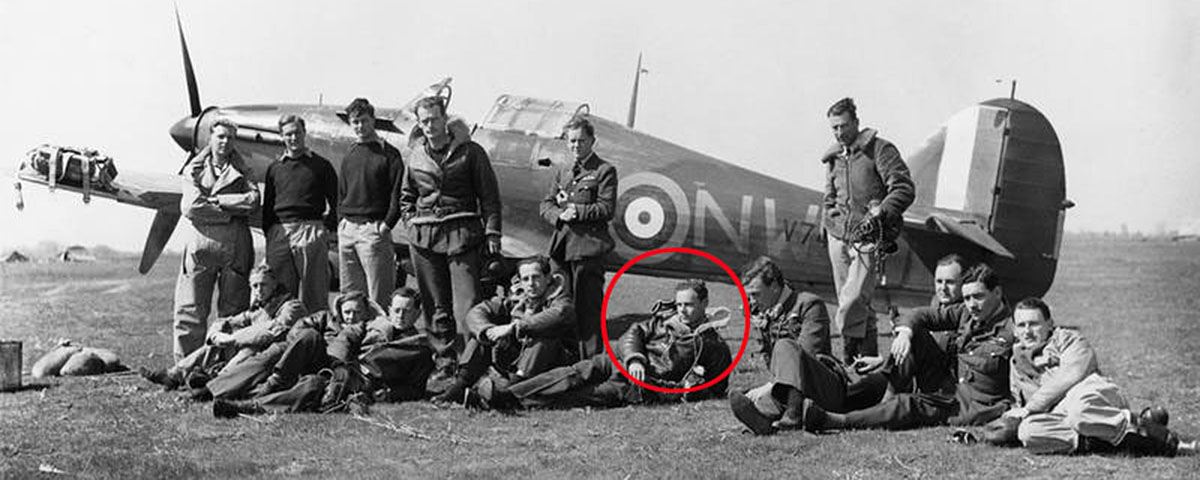South African pilot “Pat” Pattle’s star burned brightly over North Africa and Greece during his meteoric combat career.
April 20, 1941: one week before Greece capitulated to German and Italian invaders. As waves of Luftwaffe Ju-88s and Do-17s rained bombs down on Allied shipping at Piraeus, the port of Athens, a Royal Air Force Hurricane pilot swooped to the aid of a lone comrade who had recklessly charged into a swarm of escorting Me-110s. Although unable to save his friend from the Messerschmitts’ cannon fire, the Hurricane pilot shot down the lead Me-110 in flames. In doing so, however, he sealed his own fate. Seconds later, Squadron Leader “Pat” Pattle, the RAF’s Balkan top scorer, lay slumped over the controls of his stricken fighter as it plunged into the sea.
Born into a British military family in South Africa’s Cape Province on July 3, 1914, young Marmaduke Thomas St. John Pattle honed his marksmanship during tough hunting safaris across the African veldt. Rejected for pilot training by the small South African Air Force in 1933, he had almost given up hope of a flying career when in March 1936 he saw a newspaper ad for short service commissions in the RAF. Pattle had to pay his own fare to England, but by late June he was undergoing basic flight training at RAF Station Prestwick, Scotland, soloing after 6½ hours’ dual instruction. Advanced training at Ternhill in England was followed by armament training at Penrhos in Wales. Assessed as a “phenomenally good shot” with exceptional flying skills, Pilot Officer Pattle was selected for the elite No. 80 (Fighter) Squadron at Debden in Essex, flying Gloster Gauntlet biplanes.
The Gauntlets were replaced in 1937 by the derivative Gloster Gladiator, powered by a Bristol Mercury IX radial engine that gave it a top speed of 257 mph. The RAF’s last biplane fighter, the Gladiator was also its first with an enclosed cockpit. Armed with four .303-inch Browning machine guns, the responsive Gladiator was a pilot’s delight.

In April 1938, the squadron was posted to Ismailia, Egypt, assigned to provide air cover for the Suez Canal. Meanwhile, as intelligence sources monitored the expansion of Italian air power in nearby Libya, No. 80 found itself periodically involved in policing tribal insurgents. Many of these Arabs were expert marksmen who had learned deflection shooting from Lawrence of Arabia during the World War I campaign against the Turks, and they regularly scored hits on the engines and fuel tanks of overflying RAF aircraft. Forced landings in the desert were common. After one such emergency, due to an engine failure, Pattle was rescued by the doughty warriors of the Black Watch regiment. When their convoy was ambushed on the way back to Jerusalem, the diminutive Pattle grabbed a rifle and, yelling Zulu war cries, joined in a headlong bayonet charge that routed the rebels.
At the outbreak of war with Germany in September 1939, Pattle was stationed at Helwan, Egypt, where training continued with renewed urgency. During exercises defending Alexandria against mock air raids by the Bristol Blenheims of No. 211 Squadron, the obsolescent Gladiators had difficulty making more than one attack on the faster Blenheims. New tactics were plainly needed to deal with the Italian and German bombers.
When Italy finally declared war on June 10, 1940, 80 Squadron’s B Flight was scrambled to investigate an unidentified aircraft flying southwest of their base at Amriya. Eager for action, and with the sharp-eyed Flight Lt. Pattle leading them, the Gladiator pilots rapidly converged on the intruder. But their elation turned to disappointment when their quarry turned out to be a lumbering Egyptian airliner.
The squadron’s first actual combat of the war came on June 19, when Flying Officer Peter Wykeham-Barnes, piloting one of the Hawker Hurricanes with which the squadron was briefly equipped, joined four Gladiators from No. 33 Squadron patrolling around Sollum. In a clash with Fiat C.R.42 fighters of the Regia Aeronautica (RA), Wykeham-Barnes shot down two, while one Gladiator was lost.
The open-cockpit C.R.42 Falco, which the RAF Gladiators would frequently encounter in the coming months, was the Italian counterpart of the British biplane in all but the details. Slightly faster but fractionally less maneuverable, it was fitted with a variable-pitch prop that gave it a significantly better rate of climb and higher diving speed than the Gladiator, with its fixed-pitch airscrew. Against the Gladiator’s four machine guns, however, the C.R.42 mounted only two 12.7mm weapons, firing explosive ammunition that detonated on impact with virtually no penetration. And unlike the Gladiator, the C.R.42 had no radio.
In late July the eight Gladiators of Pattle’s B Flight relocated to the forward airfield at Sidi Barrani, 60 miles from the Libyan border. After they had refueled, four aircraft led by Pattle went looking for trouble near the border. Failing to find the enemy air force, they devastated an Italian road convoy with tracer fire.
Pattle’s baptism of fire in the air came on August 4. Assigned to escort a Westland Lysander on a reconnaissance mission, his four Gladiators were 30 miles inside Libya when the Lysander fired a Very light, signifying it was under attack. Diving to its rescue, Pattle and his wingman, Pilot Officer John Lancaster, at first failed to spot the enemy flight of Breda Ba.65 ground-attack aircraft escorted by Fiat C.R.32 biplane fighters, heading home after striking a British road convoy. But the other section leader, Peter Wykeham-Barnes, saw them and led his wingman, Sergeant Kenneth Rew, into an attack. Only then did Pattle observe the seven Ba.65s closing in on the Lysander. Wykeham-Barnes sent one Breda down in flames, and the others scattered northward toward the Italian base at El Adem. Rew was bounced by a C.R.32 and killed during the attack. Lancaster, with all four guns jammed, was wounded in the left arm by an explosive bullet. He returned to base with his right thumb clamped against his left radial artery, holding the stick between his knees.

No sooner had Pattle opened fire on the fleeing Bredas than two of his guns jammed. Pressing home his attack regardless, he sent one Breda down to crash-land in the desert. When the C.R.32s joined in the fight, Wykeham-Barnes accounted for one before his Gladiator was badly damaged and he was wounded. After taking to his parachute, he began a long trek across the desert. He was eventually rescued by the armored cars of the 11th Hussars.
Now alone, Pattle was 10 miles southeast of El Adem when five C.R.42s pounced, attacking independently from different directions. One of the Fiats fell to a close-range deflection shot from Pattle’s two remaining guns, but then another gun jammed. Turning for home some 40 miles inside enemy lines, he was beset by a dozen C.R.42s and three Ba.65s. Soon defenseless when his last gun jammed, Pattle was attacked from all angles, his rudder controls were shot away and he was forced to bail out.
Walking through the desert night toward what he thought was the Egyptian border, Pattle was dismayed to find at daybreak that he had actually been marching farther into Libya. He began retracing his steps, and was lying exhausted by the track when an 11th Hussars officer happened by and asked him, “Are you doing this for fun, or would you like a lift?” Back at Sidi Barrani the supposedly bush-wise South African endured much leg-pulling, particularly as city boy Wykeham-Barnes had returned to base well before him. But Pattle had scored his first aerial victories, and that, as well as avenging the ignominy of being shot down by the Italians, was all that mattered.
Having lost three Gladiators and a pilot, No. 80’s Squadron Leader Patrick Dunn decided that the best way to restore morale was to mount a squadron-strength sortie into the triangle regularly patrolled by the C.R.42s around El Adem. Thirteen Gladiators duly took off from Sidi Barrani on August 8, heading west toward the Libyan border. Approaching Bir el Gobi, they spotted a formation of Falcos estimated at 27 strong. The perfect ambush was about to be sprung.
Placing themselves in the classic 6 o’clock high position above the Italian aircraft, the Gladiators under Pattle’s tactical command prepared to attack. After a shattering first pass, British and Italians became locked into a monumental reenactment of a World War I dogfight. It was every man for himself as machine guns chattered and the biplanes swooped, climbed, looped and dived. Quickly engaged, Pattle dispatched a C.R.42 from 50 yards, firing two short bursts that sent it spinning down to explode in flames. Five other aircraft had already been shot down—but whether British or Italian, he could not tell. Sighting a lone C.R.42 close below, Pattle stall-turned his Gladiator to come down directly behind the Italian. A brief machine gun burst turned the Falco into a mass of fiery debris.
Back at Sidi Barrani, the exultant RAF pilots claimed nine confirmed kills and six probables, for the loss of two Gladiators and one pilot. (Actual Italian losses were four destroyed and four crash-landed.) The encounter confirmed to the British that sound tactics and flight discipline, enhanced by radio coordination, would always prevail over the purely aerobatic skills at which the Italians excelled. As it happened, the Italian unit most closely involved in the engagement, the elite 73a Squadriglia, which lost five C.R.42s during the first pass, had formed the nucleus of the last prewar RA aerobatic team.
A lull followed during which the chastened Italians seemed to be avoiding the RAF’s patrolling Gladiators and Hurricanes. Pattle’s last North African combat came on September 15, when he damaged a Savoia-Marchetti S.M.79 trimotor, one of a gaggle attacking Sidi Barrani during the ultimately unsuccessful Italian invasion of Egypt. Although the South African set one of its engines on fire, the bomber escaped thanks to its superior speed.
After reequipping with Gladiator Mk.IIs, and with a Bristol Bombay to transport its ground personnel across the Mediterranean, 80 Squadron set out from Egypt for Greece, via Crete, landing at Eleusis, near Athens, on November 18. Their task was to provide fighter cover for one Vickers Wellington and two Blenheim squadrons sent to reinforce the small Greek air force, which had fought valiantly on the Albanian front since the ill-timed Italian invasion of Greece on October 28. Anxious not to antagonize the Germans, the Greeks were initially reluctant to let the RAF use their northern aerodromes, a severe operational handicap during the short winter days.
The British presence in Greece was a reflection of Winston Churchill’s determination to take the fight against the Axis back onto European soil after the Dunkirk evacuation and the Norwegian debacle. There would eventually be 62,000 British and Commonwealth forces on the ground.
Moving up to Trikkala, in the central mountains, 80 Squadron flew its first mission between the snow-capped peaks into Italian-occupied Albania on November 19, four days after a successful Greek counterattack had driven the Italians 60 kilometers back across the border. In combat with Italian fighters that swarmed up from Koritza, the Gladiator pilots claimed nine destroyed. Pattle himself accounted for two C.R.42s, for his ace-making fifth and sixth kills.
Grounded by rain until November 25, the squadron seemed to shoot down Italians almost at will after that. On December 2, flying from Yanina, Pattle downed two Meridionali Ro.37 reconnaissance planes. Two days later he destroyed three C.R.42s. In the bitterly cold air, the pilots sometimes flew with the stick between their knees while banging their hands together to maintain their circulation. The Italian pilots, in their open-cockpit C.R.42s, no doubt fared even worse.
An S.M.79 and an S.M.81 fell to Pattle’s guns on December 20. The next day he sent a Falco down in flames during a savage dogfight over the Albanian front that claimed the lives of, among others, Squadron Leader William Hickey, who died after his parachute caught fire.
On January 28, 1941, Pattle shared credit for the destruction of a Cant Z.1007bis trimotor during an offensive patrol between Kelcyre and Premeti in Albania. With him was redoubtable Flying Officer Nigel Cullen. Nicknamed “the Ape” because of his phenomenal strength, Cullen was a former motorcycle racer and Spanish Civil War veteran who favored head-on aggression over aerobatic subtlety. He would soon rack up an impressive number of kills.
The new commanding officer, Squadron Leader Edward “Tap” Jones, led an offensive patrol into the strategically important Tepelene area on February 9. A series of individual dogfights soon developed, with Pattle destroying a C.R.42 after closing to within 50 yards during a rooftop chase. Cullen claimed two victims, as did two other British pilots. Pattle later learned that he had been awarded the Distinguished Flying Cross, the citation noting “he has been absolutely fearless and undeterred by superior numbers of the enemy.” Throughout the following weeks, Pattle’s score increased steadily, in line with his reputation as an inspirational fighter leader and tactician.
Yanina itself came under Italian attack the following day, with 150 heavy bombs falling on the airfield before the raiders were driven off in a series of furious engagements. Pattle claimed a Z.1007 and a Fiat B.R.20 damaged in what turned out to be his last fights in a Gladiator. Shortly after that, the first six Hurricanes arrived, and Pattle was given command of the monoplanes as a detached flight based at Paramythia, home to No. 211 Squadron’s Blenheims. Situated in mountains 30 miles southwest of the frontier, Paramythia airfield was a rough, stony landing ground without any permanent buildings.
Pattle and his pilots immediately took to the Hurricane, although they missed the Gladiator’s acrobatic abilities. Declared operational on February 20, the flight was tasked to escort a strong force of Blenheims and Wellingtons in a raid on the Italian base at Berat. When a group of Fiat G.50s attacked the bombers, the six Hurricanes led by Pattle rushed down to their defense. Pattle’s destruction of the lead aircraft was later described by a Blenheim gunner: “A G.50 came for us and in a flash a Hurricane just shot it off our wingtip. It was wizard.” On a similar mission the next day, the South African destroyed another C.R.42.
In late February, intent on gaining as much ground as possible before German forces joined in the hostilities, the Italians mounted another massive offensive. Its eventual catastrophic failure would finally convince the Germans that they had no alternative but to assist their faltering ally.
Meanwhile, February 28 saw eight Hurricanes and 19 Gladiators involved in a sprawling dogfight over Albania that resulted in the RAF claiming 27 victories, its largest single tally of the Greek campaign. Pattle himself accounted for two C.R.42s and two B.R.20s, with another Falco probable. That brought his personal score to over 20, plus numerous probables, and 80 Squadron’s tally to more than 100. Ape Cullen claimed five enemy aircraft in the encounter.
On March 4, alerted to an impending raid by the Italian navy on the Greek-held Albanian port of Himare, 15 Blenheims took off from Paramythia to strike the warships. The bombers were escorted by 17 Gladiators and 10 Hurricanes, with Pattle’s flight protecting the right flank. When G.50s attacked the fighters, Pattle destroyed three, and later probably downed a C.R.42. But his wingman, the seemingly indestructible Cullen, was shot down by a G.50 and killed.
A week later Pattle was promoted to squadron leader, to command 33 Squadron, a unit of cosmopolitan individualists rather than a closely integrated outfit like 80 Squadron. By Pattle’s demanding standards, the men lacked flying discipline, a point he rammed home by trouncing one of No. 33’s best pilots in a mock dogfight. Lingering doubts about his command ability were removed when, leading the squadron for the first time on March 23, he destroyed a G.50 in the air, plus one probable, and three more on the ground. That mission coincided with the award of a bar to his DFC, when his official score stood at 23 confirmed.
On April 6, having finally lost patience with their Italian ally, the Germans invaded Greece from Bulgaria and Yugoslavia. On that same day, during an offensive sweep over Bulgaria, Pattle’s Larissa-based Hurricanes first encountered the mighty Luftwaffe. In the arterial Rupel Pass, they engaged a formation of 20 Me-109s, quickly shooting down five, without any losses. Pattle’s wingman later said: “I never had a chance—we came up right behind this pair of 109s—Pat gave them a left and a right and it was all over. Both went down in flames.”
Soon the greatly superior German ground and air formations drove back the stubborn Greek and British ground forces. For the RAF, the retreat held depressing reminders of the fall of France, with exhausted ground crews constantly moving from one makeshift landing ground to another and then, as bases on the Larissa Plain became untenable, relocating to beleaguered airfields around Athens. Their improvisation skills were tested to the limit by the lack of spares, and maintenance was carried out under the constant threat of strafing by marauding Luftwaffe aircraft from Salonika. Pattle himself was almost continuously in action, despite suffering from influenza as well as exhaustion.
During the chaotic period when the British fighter squadrons fell back on Eleusis, Pattle certainly destroyed many more enemy aircraft, although from this point on it becomes increasingly difficult to validate the precise number. Ignoring his weakened state, he continued to lead his usual high number of sorties. Between missions he lay on a couch, feverishly sweating under a pile of blankets. From April 7 to 12, he reportedly claimed three Do-17s, a Ju-88, He-111, Me-109, Me-110 and an S.M.79 destroyed. On April 14, he claimed two Ju-88s plus an Me-109, Me-110 and S.M.79.

When Flying Officer Roald Dahl, the future author, joined 80 Squadron at Eleusis, he wrote of Pattle, “He was a very small man and very soft spoken, and he possessed the deeply wrinkled face of a cat who knew that all of its nine lives had been used up.” Time was indeed running out for Pattle, but he was back in action again on April 19, destroying three Ju-88s and three Me-109s, and sharing in downing a Henschel 126.
On April 20, after he destroyed two Me-109s in the early afternoon, the by now very sick Pattle insisted on taking off again with the defiant remnants of Nos. 33 and 80 squadrons to intercept more than 100 German aircraft homing in on Allied shipping anchored around Athens. After destroying a Ju-88 and gallantly shooting a Me-110 off the tail of Flight Lt. William “Timber” Woods over Eleusis Bay, Pattle was himself shot down and killed.
By late April, the war in Greece was over. The most experienced fighter pilots had flown the surviving Hurricanes to Crete, while other fliers were evacuated to Egypt. Meanwhile RAF Blenheims and Short Sunderland flying boats ran a shuttle service to Crete for ground crews and army personnel. Despite the air and sea evacuations, 14,000 British servicemen were captured.
Exactly how many enemy aircraft Pattle destroyed will probably never be known. All official records of the last few weeks in Greece were lost, although the 33 Squadron operations book was partially reconstructed later from intelligence summaries and personal recollections. Unofficial sources indicate he destroyed at least 44 confirmed, with 50 as a possible final total. Of those, 27 were authenticated through Italian and German records. It should be noted that Pattle himself never worried about his score; in the modest South African’s mind, the efficiency of the squadron and the safety of his pilots were always uppermost.
Although Pattle may well have been the RAF’s ace of aces, today he is hardly known outside aviation circles. This unfortunate historical oversight is largely attributable to the early Middle Eastern and Greek campaigns being widely regarded as sideshows, lacking the fascination of the Battle of Britain, El Alamein, the Normandy invasion or the Pacific War. There is no doubt, however, that in a combat career of only nine months Pat Pattle earned himself a lasting place among the immortals of air combat.
RAF veteran Derek O’Connor recommends for further reading: Ace of Aces, by E.C.R. Baker; and Wings Over Olympus, by T.H. Wisdom.
Originally published in the November 2012 issue of Aviation History. To subscribe, click here.





